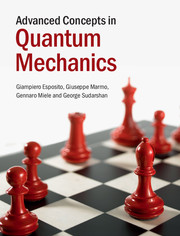Book contents
- Frontmatter
- Contents
- Preface
- 1 Introduction: the need for a quantum theory
- 2 Experimental foundations of quantum theory
- 3 Waves and particles
- 4 Schrödinger picture, Heisenberg picture and probabilistic aspects
- 5 Integrating the equations of motion
- 6 Elementary applications: one-dimensional problems
- 7 Elementary applications: multi-dimensional problems
- 8 Coherent states and related formalism
- 9 Introduction to spin
- 10 Symmetries in quantum mechanics
- 11 Approximation methods
- 12 Modern pictures of quantum mechanics
- 13 Formulations of quantum mechanics and their physical implications
- 14 Exam problems
- 15 Definitions of geometric concepts
- References
- Index
4 - Schrödinger picture, Heisenberg picture and probabilistic aspects
Published online by Cambridge University Press: 05 November 2014
- Frontmatter
- Contents
- Preface
- 1 Introduction: the need for a quantum theory
- 2 Experimental foundations of quantum theory
- 3 Waves and particles
- 4 Schrödinger picture, Heisenberg picture and probabilistic aspects
- 5 Integrating the equations of motion
- 6 Elementary applications: one-dimensional problems
- 7 Elementary applications: multi-dimensional problems
- 8 Coherent states and related formalism
- 9 Introduction to spin
- 10 Symmetries in quantum mechanics
- 11 Approximation methods
- 12 Modern pictures of quantum mechanics
- 13 Formulations of quantum mechanics and their physical implications
- 14 Exam problems
- 15 Definitions of geometric concepts
- References
- Index
Summary
This chapter begins by exploiting the Einstein–de Broglie relation and the notion of symbol. The following steps are the local and global conservation laws associated with the Schrödinger equation, probabilistic interpretation of the wave function and probability distribution, the spreading of wave packets and transformation properties of wave functions. In the last part, the Heisenberg picture is outlined at an introductory level.
From classical to wave mechanics
In the previous chapter we have seen how to go from wave equations on space–time to Hamilton equations on phase space by means of an appropriate approximation requirement on wave solutions. In more formal language, we could say we have considered a procedure to associate a Hamiltonian ordinary differential equation on phase space starting with a partial differential equation on configuration space. This association produces a correspondence between differential operators and polynomials on phase space, which relies on the notion of symbol (see below). Now we are aiming to pass from a function on phase space, i.e. the classical Hamiltonian, to an operator which, by analogy, is called the Hamiltonian operator. Such a transition is physically non-trivial because it amounts to building a wave equation from the equation on rays. From the formal point of view it appears to contain some ambiguities. Such a transition is always possible if polynomials in p have constant coefficients.
- Type
- Chapter
- Information
- Advanced Concepts in Quantum Mechanics , pp. 94 - 121Publisher: Cambridge University PressPrint publication year: 2014



